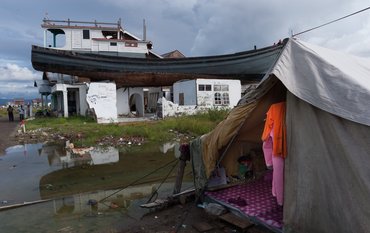New computer node receives funding from the State of Brandenburg via the Future Investment Fund
The German Research Centre for Geosciences is receiving a new high-performance computer. The GPU unit will be used, among other things, for the faster and highly accurate calculation of earthquake magnitudes and locations, the quantum mechanical calculation of mineral properties or the modelling of landscapes. GPU stands for Graphics Processing Unit and refers to a type of computer that is particularly well suited for image processing, modelling and machine learning thanks to the parallel processing of data. The computer node is being funded with 600,000 Euros by the state of Brandenburg through the Future Investment Fund. "We are particularly pleased that with the GPU cluster we will be able to meet the challenges that science poses to IT better and faster in the future," says Dorit Kerschke, coordinator of the GFZ Department "Data, Information and IT Services". "In particular, our group of researchers in the field of 'machine learning' and 'artificial intelligence' will benefit from this."
Niels Hovius, Scientific Director (interim) of the GFZ, adds: "In the geosciences, too, we are increasingly working on so-called digital twins, i.e. with models that map a part of the Earth system and its interactions and thus enable predictions or scenarios. The new GPU cluster will take us a big step forward in this. In the future, the computing power will also be made available to neighbouring institutes on Telegrafenberg."
Brandenburg's Minister of Science and Research Dr Manja Schüle: "Heavy rain, floods: the risk of extreme weather events is increasing. Predicting them remains difficult. In the future, artificial intelligence approaches such as deep learning will help to evaluate incoming environmental data even faster and to answer recurring questions automatically. Our Future Investment Fund finances these modern technologies and at the same time enables further climate protection measures. The GeoForschungsZentrum's intelligent computer nodes support the scientists on Telegrafenberg in predicting natural disasters. The digital infrastructure is another step on the way to future-oriented geo and climate research. The knowledge gained provides important scientific contributions for the future of Brandenburg, Germany and Europe. Here, the future is being predicted and made with artificial intelligence and state funding."
At the GFZ, a user and application group for Machine Learning (ML) has existed for several years, bringing together more than sixty scientists* from 17 sections of the GFZ. This group organises regular exchange meetings and development meetings ("hackathons"). All researchers work on questions for which ML is seen as a promising approach. The direct proximity to application for many communities has led to mature prototypes already being developed at the GFZ. This has allowed experience to be gained, concepts to be tested and the use of GPUs to be validated as useful for scientific computing.
The new technological possibilities are to be used to solve future challenges in the field of earth and environment. Possible applications in the environment of the GFZ are, for example, time-critical mass data calculations of geodata, modelling and simulation calculations for analyses and forecasts as well as real-time warning systems for natural hazards such as tsunamis, storm and rain floods or volcanic activity. Other applications include geotechnical monitoring systems for observing landslides, foundations and bridges, as well as disaster management for natural or man-made disasters. Niels Hovius: "Last but not least, the GPU cluster is also an essential computing infrastructure for attracting research funding in large-scale national and international projects."
The GPU system will be installed and operated in the newly created server room in the recently inaugurated "GeoBioLab" on the Telegrafenberg campus. In terms of sustainable IT operation, the resulting thermal power is used in the lab building itself and in another connected building for heating and water heating.



![[Translate to English:] Fire in a forest, smoke rising, aerial view from above](/fileadmin/_processed_/8/3/csm_2025_01_06_AdobeStock_415831729_5a0e6d50d3.jpeg)









![[Translate to English:] [Translate to English:] Abror Gafurov von dem Schriftzug "Welcome to Azerbaijan" und den UN und COP Logos](/fileadmin/_processed_/2/5/csm_2024_11_Baku_COP29_Abror_Gafurov_1042faec82.jpeg)


![[Translate to English:] Martin Herold standing in front of the library on the Telegrafenberg](/fileadmin/_processed_/c/d/csm_Martin_Herold_d385ee4dd9.jpeg)
![[Translate to English:] Many people are listening to a presentation in the GFZ lecture hall.](/fileadmin/_processed_/c/a/csm_1_Bild1_hell_b9c0e9f5ed.jpeg)






![[Translate to English:] Both scientists sitting on stools in front of a wall of books in the Telegrafenberg library](/fileadmin/_processed_/6/6/csm_Buiter_Castell_DORA_4_e87cb1ea18.jpeg)
![[Translate to English:] Gruppenbild mit 4 Personen](/fileadmin/_processed_/8/d/csm_20241017_GFZ-Emmerman-Medal-005_web_reinhardtundsommer_21a414fa4a.jpeg)






![[Translate to English:] Ice landscape with five red tents](/fileadmin/_processed_/8/9/csm_Zeltlager_auf_dem_Eis_Urheberin_Jenine_McCutcheon_5ced2d523b.jpeg)